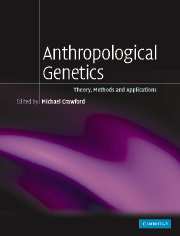Book contents
- Frontmatter
- Contents
- List of Contributors
- Preface
- Chapter 1 Foundations of Anthropological Genetics
- Part 1 Theory
- Chapter 2 Partitioning of Genetic Variation in Human Populations and the Concept of Race
- Chapter 3 Natural Experiments in Human Gene Mapping: The Intersection of Anthropological Genetics and Genetic Epidemiology
- Part 2 Methods
- Part 3 General Applications
- Part 4 Part IV The Human Diaspora
- Index
- References
Chapter 3 - Natural Experiments in Human Gene Mapping: The Intersection of Anthropological Genetics and Genetic Epidemiology
Published online by Cambridge University Press: 05 June 2012
- Frontmatter
- Contents
- List of Contributors
- Preface
- Chapter 1 Foundations of Anthropological Genetics
- Part 1 Theory
- Chapter 2 Partitioning of Genetic Variation in Human Populations and the Concept of Race
- Chapter 3 Natural Experiments in Human Gene Mapping: The Intersection of Anthropological Genetics and Genetic Epidemiology
- Part 2 Methods
- Part 3 General Applications
- Part 4 Part IV The Human Diaspora
- Index
- References
Summary
Researchers in anthropology, epidemiology, and human genetics have been investigating the sources of human variation and the etiology of human diseases over the past century, largely independently of one another, using very different methodologies to study environmental factors, infectious agents, genetic variation, and their respective effects on human phenotypic variation. Human geneticists have had success in identifying DNA sequence variations which ‘cause’ a variety of clearly inherited ‘Mendelian’ conditions (Terwilliger and Goring, 2000), similar to the successes of epidemiologists in identifying ‘causal’ risk factors which by themselves dominated the trait's etiology. However, once many of the major ‘sledgehammer’ risk factors were identified for each of these flavours of risk factor (genetic, environmental, and infectious), researchers began to focus in earnest on the more complex family of common traits related to normal variation, which are of predominant public health relevance, and which are hypothesized to be influenced in a small way by each of numerous risk factors, potentially of each type (Weiss and Terwilliger, 2000) – that is to say epidemiologists and human geneticists have been moving into areas where anthropologists have been for decades, applying a new set of tools to old problems. However, the standard toolkit of epidemiologists and medical geneticists are not the most appropriate for this problem, as anthropologists have been aware for a long time, and this application of unmodified tools from classical health science has been very difficult to translate to studies of normal variation in humans, since the etiology is much more complex.
- Type
- Chapter
- Information
- Anthropological GeneticsTheory, Methods and Applications, pp. 38 - 76Publisher: Cambridge University PressPrint publication year: 2006



